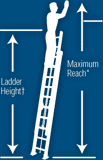Carpenter's levels have come a long way since the 14th century B.C. Back then the Egyptians had figured out that a weighted string represented a plumb line. Furthermore, they realized that something level was opposed to this plumb line by 90 degrees. Using a simple A frame device, they created highly accurate levels. In fact this design persisted until the middle ages.
Accuracy
Up until a few years ago, I didn't realize that there was such a wide variance in the accuracy of carpenter's levels. Many of my first levels were very inaccurate. The space between the edges of the bubbles and the lines on the vial were huge. You always were guessing if the bubble was centered. I even had a level where the bubble was actually bigger than the space between the two lines.
The accuracy issue, I came to find out, lies in the vials themselves. Not all vials are made the same. The most important requirement of a level is the sensitivity of the vial itself. Federal specifications call for a 45 minute minimum vial sensitivity. The test for vial sensitivity is easy. Put a carpenter's level on a table. Adjust the table or surface till the level reads "level". If you swing one end of the level around like the hands on a clock and the bubble moves, the vial may have poor sensitivity.
Mounting the Vial
The vials are always installed in a holder which is then set into the level. The best levels have their vials either plastered in place or machined into the level body so that the vial holder can't move. Some inexpensive levels have the holder siliconed into place. The silicone can distort if the level changes shape or is stressed.
Marking the Vials
Most level vials are mass produced. The curved glass is not always the same. The amount of fluid in the vial may be off by half a drop or so. This means that the bubble in the vial is not always the same size. We discussed the problems this causes earlier.
It would stand to reason that the best levels would be ones where the vial marking lines actually line up with the edges of the bubble. It is a time consuming process, but the results are well worth it. One manufacturer, Macklanburg-Duncan, does, in fact, go to these lengths to produce a precision tool.
Acrylic Vials
Some levels you may look at have acrylic vials. Starting with a solid block of plastic, the vial manufacturer hollows out the chamber with a precision grinding tool. The hollowed out area is actually shaped like a barrel. The advantage to this is that the bubble will always try to seek the highest part of the vial. Thus, if the grinding was done correctly, the level should read accurately no matter which edge you use. However, once again the grinding process may not be carefully controlled. Vial sensitivity is the key. If the number is available, ask for it. The lower the number falls below 45 minutes the more sensitive it is.
At least one manufacturer, Stabila, offers a lifetime guarantee on their acrylic vials. They claim that the level will maintain an accuracy of 1/32nd of an inch over 6 feet for the life of the level.
Care of Levels
Have you ever seen a contractor's pickup truck with a gun rack in the rear window? Often you may see levels hanging in these racks. What a mistake! Wooden carpenter levels almost always have a predrilled hole at one or both ends. You should hang the level from this hole when not in use. This eliminates stress on the level. Levels in direct sunlight in a closed up truck cab are like being in a sauna!
If you use a level in masonry work, periodically during the day use a damp rag to wipe away mortar and cement particles. Dry the level immediately with a dry rag. Absolutely NEVER immerse the level in a bucket or trough of water to clean it!
Periodically coat the wooden level with a thin film of tung oil for protection. Don't saturate it with oil, as this may also cause it to warp.
Levels are an important tool. Buy a good one, take care of it, and your jobs should be plumb, level, and true. If the Egyptians could build using their primitive, yet effective, tool there is no reason we can't do the same.
Column B126



